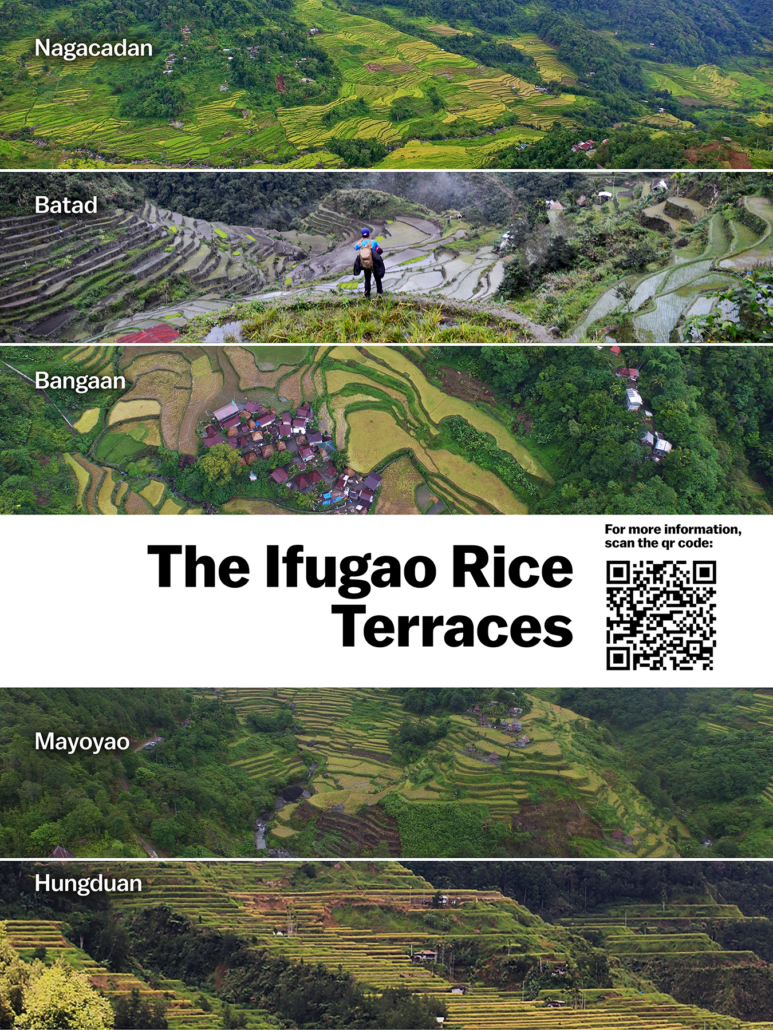The Ifugao Rice Terraces
The Ifugao Rice Terraces are UNESCO World Heritage Sites because of the ability of the Ifugao (the people who constructed these magnificent agricultural monuments) to modify the landscape. Recent archaeological, historical, and ethnographical investigations suggest the terraces are not 2,000 years old; they are about 400 years old. The construction and expansion of the terraces are responses by the Ifugao against Spanish conquest, allowing them to consolidate their political and economic resources, facilitating successful resistance against conquest.
———————————————————————————————————————————————–
They grace our 20-peso bill, take center stage in tourism ads, and form the backdrop of many a souvenir photo. Inscribed into the UNESCO World Heritage List in 1995, the Ifugao rice terraces (IRT) of the Philippines are undoubtedly a source of pride for the Ifugao and for Filipinos all over the world. A lot of that pride comes from being told by our textbooks that they are 2,000 years old. But they are not. Does that mean we should be any less proud?
Despite the lack of scientific basis, the ‘long-history’ model, which says the terraces are 2,000 years old, has become a widely accepted truth. Many also repeat the unsupported claim that the terraces were built by the ‘second wave’ of Malays who went up to the mountains, or the myth that the Chinese had a hand in constructing the terraces. But recent research suggests the oft-repeated narratives are wrong, and are rooted in the colonial mindset, which sees the Ifugao as incapable of modifying their environment with such sophistication in only a short amount of time.
Recent research suggests the 2,000-year-old origin narrative is wrong and is colonial in nature. When we say colonial, we refer to a narrative that devalues local realities by instead imposing an outside version of what possibly could have been. Many historians and tour directors romanticize the 2,000-year-old origins that early anthropologists claimed for the terraces. This romanticism perpetuated a historically flawed narrative of the Ifugao as a people and as a culture. It also reinforced lowland perception of their highland compatriots as being backward and unchanging. In the wider scale of human history, complex agricultural societies developed into kingdoms and empires; people questioned, if the Ifugao developed irrigated agriculture 2,000 years ago, why did they not also develop kingdoms and empires?
The complexities of the Ifugao are in the details: The terraces are the products of the rich and complex Ifugao culture that resisted the Spanish conquest for more than two hundred years while the rest of the country became Hispanized. Archaeological excavations show the Ifugao converted to wet-rice production as a strategy to consolidate economic and political resources that then allowed them to resist the marauding Spanish forces during the onset of colonization. It cemented the social order, unified the Ifugao against invasion, and sealed a social organization that maintained the terraces and preserved these mountain settlements. The 2000-year narrative fails to capture the importance of colonial resistance within Philippine history.
The terraces qualify for the UNESCO World Heritage List because they meet the Outstanding Universal Values. But more importantly, they also commemorate the struggle against imperialism and the emergence of self-sufficient, sustainable communities surviving against the odds of a modernist onslaught. In fact, the rice grown in the terraces is from heritage seed stock and is used to strengthen cultural identity maintain community rituals.
The terraces are tourist sites today, but the Ifugao persevere to maintain their culture to educate the youth about traditional farming methods, which has shown resilience against droughts and typhoons. In the face of changing climate, these refugia are the hopes for the future of humankind.


